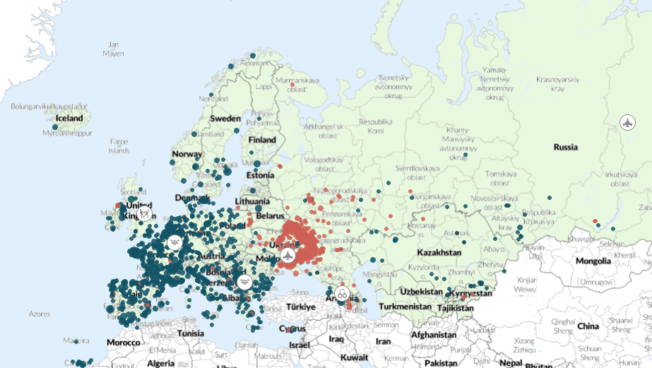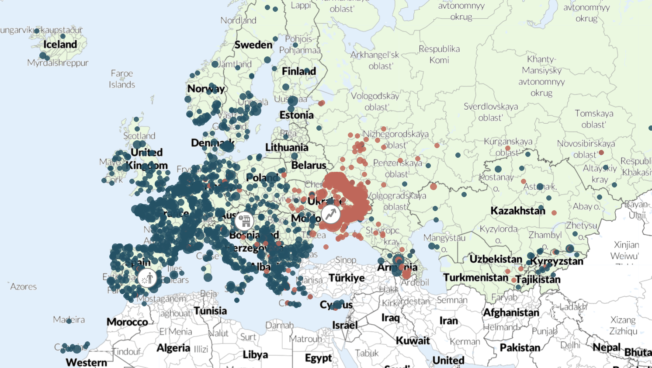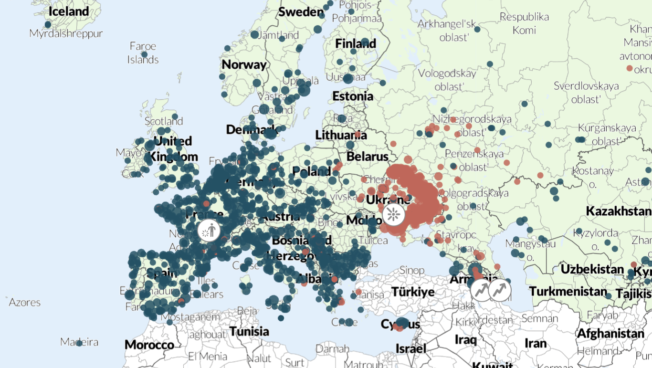Regional Overview
Europe and Central Asia
May 2025
Posted: 8 May 2025
In this Regional Overview covering April 2025
Armenia-Azerbaijan: Gunfire along borders intensifies
In April, ACLED records at least 50 instances of gunfire along the Armenia-Azerbaijan border — a nearly 20% increase compared with already heightened levels in March. Together, they mark one of the most significant escalations since September 2023, when Azerbaijan recaptured Artsakh.1The disputed territory of Nagorno-Karabakh is internationally recognized as part of Azerbaijan. ACLED refers to the former de facto state and its defunct institutions in the hitherto ethnic Armenian majority areas of Nagorno-Karabakh as Artsakh — the name by which the de facto territory used to refer to itself. For more on methodology and coding decisions around de facto states, see the methodology primer about Central Asia and the Caucasus on ACLED’s Knowledge Base. Armenia’s southern Syunik region accounted for over 60% of all claims of ceasefire violations. In addition, eight instances of gunfire occurred in the northern region of Tavush, where the sides delimited a section of their border in 2024.
Significantly, Armenian sources reported on the majority of these instances, including three events in which Armenia’s defense ministry reported damage to civilian infrastructure and residences. Prior to March, the ministry had refuted sporadic Azerbaijani claims of ceasefire breaches but rarely made claims itself amid efforts to conclude a peace agreement with Baku. Neither side reported any casualties.
Armenia’s Prime Minister Nikol Pashinyan played down concerns of renewed violence, suggesting that the occurrences are random.2Arshaluys Barseghyan, “Pashinyan insists ‘there will be no war,’” Open Caucasus Media, 16 April 2025 Meanwhile, the European Union Mission to Armenia increased its patrols across the country, including at night.3X @EUmARMENIA, 9 April 2025 Tensions were further exacerbated during the month by an Armenia-Iran military exercise on both sides of the shared border,4Felix Light and Elwely Elwelly, “Armenia and Iran hold joint military drills amid strains over Azerbaijan, nuclear program,” Reuters, 10 April 2025 Armenia’s regular call-up of reservists,5Xandie (Alexandra) Kuenning, “Armenia again denies ceasefire violation as new round of army reserve exercises are approved,” Open Caucasus Media, 11 April 2025 and a secretive Azerbaijani military exercise in its Nakhchivan exclave sandwiched between Armenia, Turkey, and Iran.6Yousef Bardouka, “Azerbaijan holds military drills ‘in Nakhchivan’ as tensions with Armenia continue,” Open Caucasus Media, 2 May 2025
France: Drug traffickers attack prisons and their staff
Between 13 and 22 April, 16 coordinated arson attacks targeted prison buildings and prison guards across France. Amid the attacks, unidentified perpetrators also threw Molotov cocktails and shot at a house they believed to belong to a prison guard in Villefontaine, Auvergne-Rhône-Alpes, on 20 April. However, the dwelling was inhabited by a pensioner, who was left unharmed. In most instances, perpetrators torched cars outside detention centers and spray-painted “DDPF” inscriptions, standing for “Défense des droits des prisonniers français” (Group for the Defense of French Prisoners’ Rights), a hitherto unknown group. It claimed on Telegram to be advocating for the respect of human rights in prison. Between 28 and 30 April, police arrested 30 suspected members of the DDPF. Seven of them were already in prison during the attacks, while two of them were minors.7France Télévisions, “Prison attacks: what we know about the investigation, in which 21 suspects have been indicted,” 2 May 2025 (French) Counter-Terrorism Prosecutor’s Office investigators ruled out a political motive and said that the DDPF had been created and led by inmates with ties to the DZ Mafia — a violent Algerian drug trafficking gang that has recently asserted its authority over smuggling routes around Marseille, intimidating and attacking businesses and other traffickers to extend its influence.8Annie Vergnenegre, “‘You pay or you die’: drugs, racketeering, extortion, how in 2024 the DZ Mafia became the first criminal gang,” France 3 Régions, 30 December 2024 (French); France Télévisions, “Marseille: the DZ mafia, known for drug trafficking, attacks bars and restaurants,” 15 January 2025 (French); Damien Delseny and Jean-Michel Décugis, “‘They stop at nothing’: drug kingpins defy the state by attacking prisons,” Le Parisien, 16 April 2025 (French); France Bleu, “Prison attacks: a prisoner considered a member of the DZ Mafia suspected of creating the ‘DDPF’ channel,” 2 May 2025 (French)
In recent years, French penitentiary staff have faced increased threats from gang members. In May 2024, two guards were killed during the escape of detainee Mohamed Amra from prison in Incarville,9Sophie Neumayer, “Attack on a van in the Eure region: what stage has been reached in the hunt for Mohamed Amra and his accomplices?” RTL, 18 May 2024 (French) which triggered a wave of protests demanding more staff and a solution to overcrowded cells.10Le Point, “Prison blockade after prison van attack: unions call for end to movement,” 18 May 2024 (French) Amra was eventually extradited from Romania in February.
Russia: Fighting in border areas slows down; a car blast kills another general
On 26 April, the chief of Russia’s General Staff, Valery Gerasimov, claimed that the Kursk region had been fully cleared of Ukrainian armed forces following their withdrawal to positions on either side of the border in March.11Russian News Agency TASS, “Russia’s military chief reports on complete liberation of Kursk Region,” 26 April 2025 ACLED data show no battles in the region between 26 and 30 April, though official Ukrainian sources and some Russian military bloggers alleged ongoing fighting.12Daria Novikov et al., “Russian Offensive Campaign Assessment, April 26, 2025,” Institute for the Study of War, 26 April 2025 The alleged cessation of fighting in the region came on the back of a 75% decrease in violence in April compared to the month prior. Border clashes in the neighboring Belgorod region continued, but also subsided closer to the month’s end. Both Russian and Ukrainian troops may be redeploying from the Kursk and Sumy regions for a possible looming Russian offensive in Ukraine itself.13Meduza, “Moscow’s spring offensive begins,” 15 April 2025
Meanwhile, on 25 April, suspected Ukrainian operatives killed General Yaroslav Moskalik with an explosive device attached to a car near his residence in Balashikha near Moscow. Moskalik was a senior operations officer at Russia’s General Staff.14Vicky Wong, “Senior Russian general killed by car bomb in Moscow,” BBC, 25 April 2025 This is the second Russian general likely assassinated in connection with the war in Ukraine, after the killing of the head of a chemical weapons unit in December 2024. Earlier in April, another car bomb killed a civilian engineer involved in designing electronic warfare systems for the Russian army in Bryansk, similarly to the assassination of a missile designer near Moscow also in December 2024. Since Russia’s all-out invasion of Ukraine in 2022, suspected Ukrainian operatives have killed several military officers in Russia, a turncoat former member of Ukraine’s parliament, an occupation governor of the Kharkiv region, a propagandist, as well as the daughter of a Russian nationalist ideologue.
Ukraine: Russia advances slowly amid increased targeting of civilians
The pace of the Russian occupation of Ukraine appeared to slow further in April after stalling since January. Russian forces seized a total of 13 settlements, compared with 16 in March. Of these, 11 were in the directions of Pokrovsk and Kostiantynivka in the Donetsk region. The advances came at a staggering loss of personnel.15Angelica Evans et al., “Russian Offensive Campaign Assessment, May 2, 2025,” Institute for the Study of War, 2 May 2025 Nevertheless, Russian forces broke through a Ukrainian line of defense in the direction of Lyman, a town north of the Kramatorsk-Slovyansk-Kostiantynivka urban agglomeration. It is already threatened from the south and is Ukraine’s last stronghold in the Donetsk region after Pokrovsk, which Russian troops attempted to envelop from the southwest rather than attacking head-on. After recapturing most of the adjacent Russian Kursk region, they also gained a foothold in the Sumy region.
Despite engaging in US-brokered ceasefire talks16Reuters, “Exclusive: Documents expose differences over U.S. peace drive for Ukraine,” 25 April 2025 and announcing unilateral truces, Russia persevered in carrying out indiscriminate attacks on populated areas across Ukraine, pushing the civilian death toll to nearly 200 in April — a third more than the average in the previous 12 months. The spike was due to a series of repeated ballistic missile strikes on Kyiv, Kryvyi Rih, Kharkiv, and Sumy cities, which killed at least 75 civilians and injured 435 others. In the case of the latter three cities, the missiles carried cluster munitions. Ballistic missiles are difficult to intercept, while cluster munitions scatter large areas with explosives, increasing the threat to civilians. Ukrainian authorities also claimed in April that Russian drones have begun to scatter explosives, putting civilians at further risk, even if intercepted.17Anna Fratsyvir, “Russia using drones to drop explosives across Ukraine, Interior Ministry warns,” The Kyiv Independent, 10 April 2025
For more information, see the ACLED Ukraine Conflict Monitor.
See More
See the Codebook and the User Guide for an overview of ACLED’s core methodology. For additional documentation, check the Knowledge Base. Region-specific methodology briefs can be accessed below.
Links:
For additional resources and in-depth updates on the conflict in Ukraine, check our dedicated Ukraine Confict Monitor.







